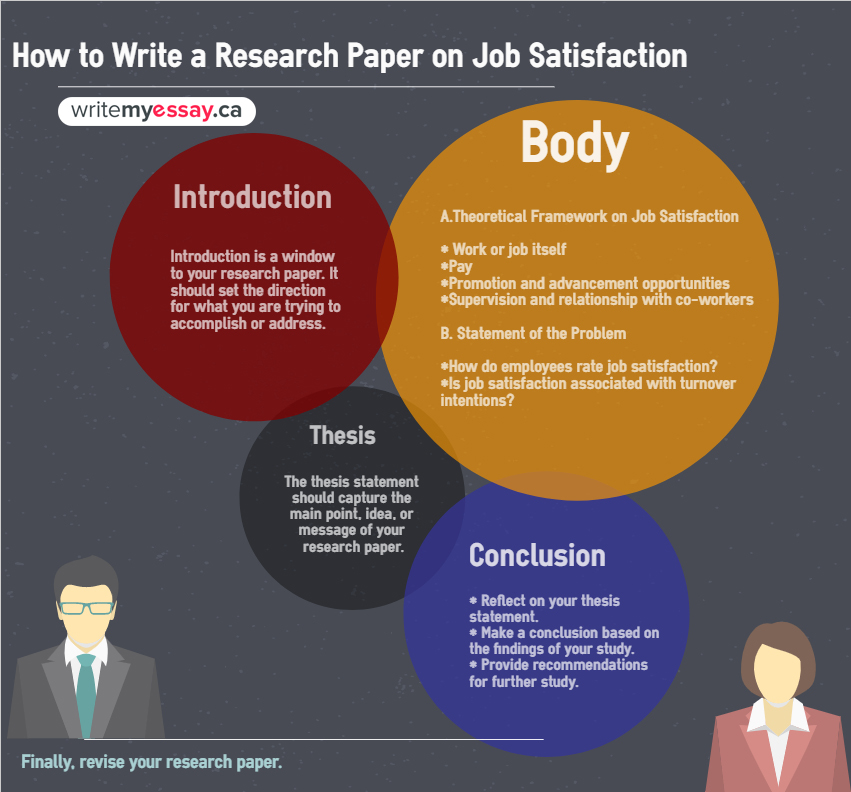
How to Write a Research Paper on Job Satisfaction

Table of Contents
Writing a Research Paper on Job Satisfaction
- How to start a research paper on job satisfaction
- Example of an outline
- How to write an introduction
- How to write a thesis statement
- Example of a thesis statement for a research paper on job satisfaction
- Example of an introduction
- How to write body paragraphs for a research paper on job satisfaction: Tips on body writing
- Example of body paragraphs
- How to finish a research paper on job satisfaction
- Example of a conclusion
- Research paper revision

How to start a research paper on job satisfaction
Job satisfaction is a very broad topic for research. The studies produced over the years have expanded the aspects involved in this topic. In fact, some researchers argued that this is overstudied. Most especially that organizations and human resources have evolved. There might be new practices and trends that have given employees a new perspective to what satisfies them on their jobs. But if we express deep interest in further study job satisfaction, a few readings will help in coming up with a research problem.
So, before designing a research outline on job satisfaction, a background on the variables will be necessary because it will be used as the main focus; it can also set limitations to the study. Thus, it helps avoid the research to be broad and to lack the focus. A consultation with a research adviser may also be a wise move for the study to have direction on how to write your paper. And this can help you formulate the research topic. It will be a waste of time if getting the opinion of experts will be done after one has produced the research paper because major revisions will be expected.
Another way to come up with a paper on job satisfaction is to read books and journals. Books on human resource management can provide extensive details on job satisfaction. Journals and previous researches can also help in formulating the research topic or statement of the problem. These books and journals may be acquired in school or public libraries but also online. But be selective on online sources, read and evaluate thoroughly even though they may still be reliable. Always keep a list of the books, journals, and websites that are able to provide substantial information. These will be used as references in which full bibliographical information should be documented.
Example of an outline
- INTRODUCTION
BODY
- A.Theoretical Framework on Job Satisfaction
- Work or job itself
- Pay
- Promotion and advancement opportunities
- Supervision and relationship with co-workers
- B. Statement of the Problem
- How do employees rate job satisfaction?
- Is job satisfaction associated with turnover intentions?
- CONCLUSION
How to write an introduction
Other than the topic, lay out some the keywords and/or variables that are directly related to job satisfaction; they will set the parameters of the study. These will indicate what problems you are trying to address. But do not forget to define or simplify some keywords that are way too technical. By doing this, the readers will understand the argument that you are trying to resolve or prove. Remember, the introduction is a window to your research paper. It should set the direction for what you are trying to accomplish or address.
How to write a thesis statement
The thesis statement should capture the main point, idea or message of the research paper. It may be composed of one or two statements. In that, the title should be presented and the researcher’s position on the topic. In other words, the thesis statement has to project what the research is about and what it is focused on.
Example of a thesis statement for a research paper on job satisfaction
For example, you wanted to conduct a research to reveal if the main reason why employees want to leave the organization is the level of satisfaction in their jobs. Ex. Job satisfaction is significantly related to turnover intentions. The more employees are satisfied with their jobs, the less likely they would want to leave the organization.
Example of an introduction
Employees in different organizations are always confronted with issues of job satisfaction and retention which spark concern among managers and administrators. Employees’ retention and minimization of turnover are among the major functions of top management. Getting the right people and keeping them are some of their major concerns. Most studies on job satisfaction and retention are done extensively across different organizations. Some experts say that the health of the organization is dependent on the job satisfaction of employees. If this is the case, administrators or managers should also be sensitive to the factors that make their employees satisfied and retained with their jobs.
How to write body paragraphs for a research paper on job satisfaction: Tips on body writing
- Gather all information you got from books and journals.
- Organize them based on the outline.
- Paraphrase the information and make sure you make it cohesive; do not forget to acknowledge the source.
- The direction of your writing should be that it will answer your statement of the problem.
- It is best that you use your own words as you understand the theories because it will be your best defense when presenting your paper.
Example of body paragraphs
McShane and Glinow (2005) stated that job satisfaction signifies how an employee evaluates the context of his or her work. But this study is limited to work or job itself; pay, promotion and advancement opportunities; supervision and relationship with co-workers and supervisors. According to Noe et. al. (2004), several aspects of the job results in dissatisfaction. They further stressed that the difficulty of the job assignment, the amount of physical energy and effort required, and the how the employee regarding the task’s importance are significant in pointing out the degree of satisfaction employees have on their jobs. They pointed out, in general, that employees are bored and dissatisfied with simple repetitive jobs.
Saari and Judge (2004) claimed that the predictor of job satisfaction is the nature of the job. This includes how challenging the job is, independence when working and variety and scope of the tasks given. Thus, the nature of the job itself has particular significance on the level of job satisfaction. If employees like how tasks are assigned to them as well as the distribution of responsibilities throughout the department or unit, then, they are less likely to quit.
Pay is another element of job satisfaction. There are two ways how dissatisfaction with pay contribute to how employees feel about their jobs. For one, it makes them want more money. Another is that the job may seem less appealing. The employee who demands money has the tendency to join activities that will encourage more pay from employers. Examples are joining unions, resigning, or seeking grievance from labor groups. When the job becomes less appealing, it is possible that the employee will start to incur absences, gets late or soon will quit (Byars and Rue, 2001).
Relationship with co-workers is another dimension of job satisfaction. How colleagues treat each other has an impact on job performance, commitment and the willingness to stay in the organization. When coworkers are accommodating, generous and supportive of anything related to work, it can create a healthy working environment (McShane and Glinow, 2005).
Promotion and Advancement Opportunities. Corpuz (2006) emphasized that promotion is regarded to be the best incentive for employees who exert valuable effort, loyalty and excellent performance. Furthermore, she espoused that there is a significant correlation between opportunities for advancement and high levels of job satisfaction.
Supervision is the last dimension of job satisfaction identified in the study. Supervisors who are reasonable, give equal treatment, understanding and knowledgeable encourage employees to be satisfied with their jobs (Corpuz, 2006).
Vigoda-Gadot and Ben-Zion (2004) said that turnover intentions are actually good indicators of good organizational productivity and performance. According to them, this has also been acknowledged as job exit, quitting or withdrawal. Which means that the employee is without a doubt giving up the current job for a better job elsewhere. When an employee thinks of leaving, this thought may indicate that one is not satisfied with the job or the situation at work. The pay and benefits system and the organizational culture have a strong influence on the decision making process whether an employee will stay or quit the job.
How to finish a research paper on job satisfaction
- Reflect on your thesis statement. The thesis statement works like a hypothesis. Consider if the thesis statement is justified or rejected after conducting your research on job satisfaction.
- Make conclusions based on the findings of your study.
- You may start to get important points from the findings and end with your thesis statement if it is proven or rejected.
- Make recommendations for further study.
- Review the constructed sentences, some research panel is very particular about how you write your conclusion.
Example of a conclusion
As a whole, employees are generally satisfied with the different aspects of their job in terms of nature of work, pay, promotion and advancement opportunities, supervision, relationship with co-workers. This implies that the organization’s current practices or systems involving employee’s job satisfaction are reasonable but not strong enough to make employees very satisfied. Age is a source of variation of how employees regard their job satisfaction, commitment and turnover intentions. Employees have an inclination to be more satisfied with their jobs as they get older; the more likely they become committed to their job and be more predisposed to stick with the organization. As such, the less likely would their intentions be to leave compared to their younger counterparts. In a nutshell, job satisfaction is a predictor of turnover intentions among the employees. Therefore, job satisfaction is significantly linked to turnover intentions. The more employees are satisfied with their jobs, the less likely they would want to leave the organization.
Research paper revision
- Be humble to follow the recommendations and/or corrections from the research advisor or the research panel.
- Assert only when necessary, you as the researcher should know well enough about the paper you made but also consider the view of experts. They will help you grow.
- If there are recommendations and corrections you do not understand, ask. Do not assume you understand it. It will lead to more revisions.


